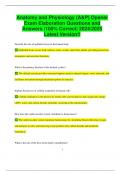Exam (elaborations)
Anatomy and Physiology (A&P) Opener Exam Elaboration Questions and Answers |100% Correct| 2024/2025 Latest Version!!
Anatomy and Physiology (A&P) Opener Exam Elaboration Questions and Answers |100% Correct| 2024/2025 Latest Version!! Describe the role of epithelial tissue in the human body. Epithelial tissue covers body surfaces, lines cavities, and forms glands, providing protection, absorption, and ...
[Show more]



